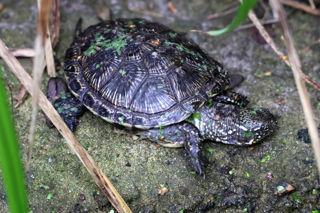
Pond Terrapin
Emys orbicularis
Pond Terrapins are medium sized turtle. Adults range from 18-20cm in length, with females being typically larger than males. They are brown, black or olive in colour, normally with yellow spots and streaks on their shells and even on their skin. Markings vary between individuals.
Behaviour
Like all reptiles, pond turtles bask during the day to raise their body temperature, often lying on stones or river banks motionless. During the winter months, they bury themselves into mud and hibernate until spring time, also known as 'to brumate.'
Are known to be territorial (especially the males), but pairs will form and live in small groups. Like all reptiles, their activity levels are dependent on environmental conditions and seasons, especially to temperature (eg the graze with it's cooler, and when it's warmer).
UK Status
Pond turtles would’ve been present in the wild in the UK around 5,500 years ago, but later became extinct due to climate cooling and oceanisations (creation of new oceans). There are populations living wild in the UK now, however these are most likely the result of escapees that have become established relatively recently. They are still regarded as a non-native species, although this is a highly debated topic.
Threats
Due to their reliance on environmental conditions, climate change is an important factor in effecting pond turtle numbers across its range. Habitat loss and modifications such as roads and traffic also effect numbers, not only by collisions but also the act of fragmenting habitats and creating physical barriers for animal movement.
The most persistent threat to terrapins is competition with the invasive red-eared sliders (Trachemys scripta elegans). Physically larger and higher fecundity (ability to produce lots of offspring), they outcompete the terrapin for food, basking spots, and nesting sites.

Distribution
Thirteen subspecies, with a wide European distribution (scarce in the north). Has become extinct in some parts of its historic range (eg UK, Sweden and Denmark) due to climate change. Successful reintroduction and breeding in Liguria, Italy, which started in 2000, has potentially prevented their extinction. Also found in north Africa and Asia Minor.
Habitat
Semi-aquatic species, found in freshwater ponds, lakes and rivers with slow moving water and soft mud or sandy bottoms with 30-90% plant coverage. Prefers wetland areas that are surrounded by large natural wooded areas.
Diet
Opportunistic omnivorous diet, with females having higher levels of invertebrates in their diet during the reproductive season. Prey items include insects, frogs, worms and fish, but with 97,9% of their diet consisting of plants, including seeds and leaves. Food and prey is highly dependent on seasonality and varies from country to country.
Family facts
Individuals have been known to live for 120 years.
-
![2024.10.01 Terrapins]()
Wildwood animal adoptions last for one year and are the perfect gift for any animal lover. Each adoption helps support our work to save British wildlife. We have different levels of adoption available to suit all occasions and budgets.
ADOPT ME!
-
![Pondterrapin1]()
Find out how you can support our conservation work and join our fight.
Support us


